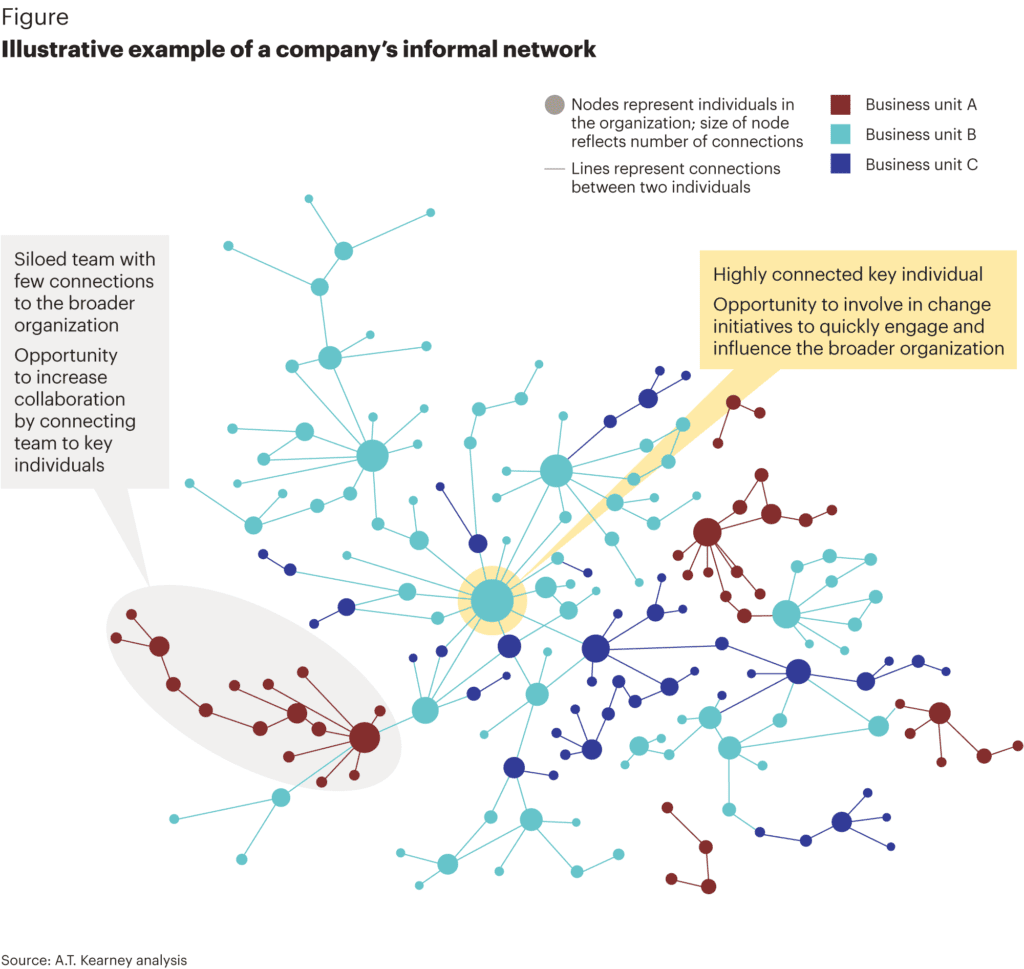
Mobilizing informal networks helps executives drive their priorities.
by Alyssa Pei and Candice Yee
July 24, 2018
A company’s talent yields the most meaningful effect when it focuses on what matters most.
The 400 C-level executives and board members responding to A.T. Kearney’s most recent “Views From the C-Suite” global survey were quite clear about what matters most to them:
- Successfully adopting new technologies.
- Improving business model efficiency.
- Improving strategy execution.
Less clear, however, is whether executives are consistently doing everything in their power to pursue their priorities. Specifically, while top executives tend to be very adept at leading through formal organizational structures, few actively harness the power of the informal networks, even though the latter largely determines what actually gets done.
Invisible Forces
Informal networks arise naturally in organizations, shaped by personalities and relationships rather than by job titles and work functions. They operate independently from the company’s formal organizational structures. In fact, informal networks are often a much more powerful conduit of influence, information and ideas than the formal chain of command.
We all know informal networks exist. We perceive them through the employees who always have the latest information, the teams that constantly innovate despite being outside R&D and the individuals with that intangible ability to spread ideas and influence others. They are part of the informal networks undefined by any organizational chart.
However, unlike the formal organization structure, informal networks tend to be mostly invisible to leaders, leaving executives with little or no control over powerful forces that significantly shape their employees’ daily priorities and actions.
Fortunately, we can accurately and objectively map informal networks through rigorous analytical techniques. Leaders can then harness the resulting insights to tackle what matters most to them: mobilizing informal networks to drive successful adoption of new technologies, improving business model efficiency and accelerating strategy execution.

A major insurance company, for example, was struggling to digitize its processes (a C-suite priority, as digitizing was clearly critical to remaining competitive). A map of the company’s informal networks revealed that the IT function was highly isolated from the rest of the business — a likely reason that the effort to digitize key operations was going slowly. On the plus side, a handful of individuals in IT were central to the company’s informal networks, and so could be tapped to open a conduit between the company’s IT experts and key members of customer-facing teams.
This insight led the company’s executives to make a crucial change. They had been selecting individuals to lead strategic initiatives based on traditional criteria such as experience and expertise while under-weighting equally critical capabilities such as informal influence, trust and access to key stakeholders. The leaders revised their project leader selection process, appointing individuals who not only possessed the standard qualifications, but could also accelerate the digitization initiative via their critical roles in the company’s informal networks. The new approach had the added benefit of identifying individuals who were highly capable but not well known to the leadership team, effectively increasing the organization’s baseline capacity without adding any additional resources.
Who’s Who
Indeed, one reason companies so often struggle to fulfill strategically vital objectives is they simply do not know who in the informal network possesses the strengths required to initiate and sustain momentum. Informal network mapping closes that information gap by identifying the following types of people:
Influencers. Certain employees are respected sources of information, advice and motivation, regardless of their place in the formal hierarchy. Such individuals can provide invaluable support to executives seeking to communicate what matters most, while ensuring that people across the organization feel ownership for those priorities.
Brokers. Some individuals are highly connected with colleagues across the organization’s formal dividing lines. Leaders can recruit brokers to bust silos and bring together different perspectives to coordinate efforts and solve complex problems.
Confidants. Employees others turn to for advice on sensitive work and personal issues can be instrumental in moments when executives need people to move out of their comfort zones by helping their colleagues advance through the emotional trials of change.
Innovators. In every company, colleagues admire certain individuals and teams for their creativity and boldness. Executives should task innovators with helping the organization feel confident when stretching beyond what it believes it can do and to lead efforts that must break new ground.
Energizers. Sustained pursuit of crucial objectives inevitably brings on periods of organizational fatigue. Executives can tap energizers to help their colleagues recharge and recommit. Energizers can also play a powerful role in spreading successful innovations across the organization.
Lead Outside the Boxes
Executives often cite employee resistance as the main obstacle to fulfilling their strategic objectives. The solution? Lead outside the boxes of the formal organization chart. Mobilize informal networks to focus your talent on what matters most.
Alyssa Pei is a partner in the leadership, change and organization practice at A.T. Kearney, the global management consulting firm. Candice Yee is a principal in the same practice. To comment, email editor@talenteconomy.io.



